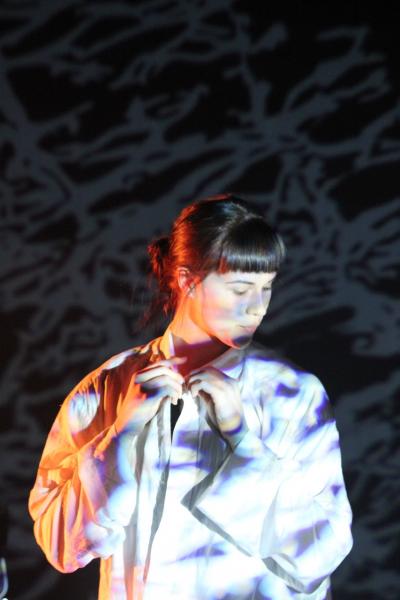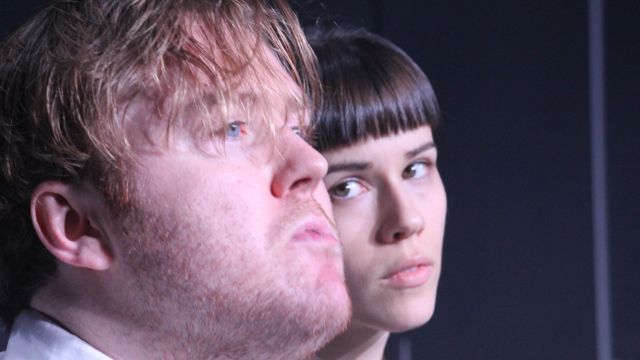Flat Out Like a Lizard
Flat Out Like a Lizard promises to be a series of Aussie stories told through the eyes of a central character, Lazarus White. In the opening monologue, Lazarus warns us that we will have to listen to this series of stories, and experience words in a verbal jigsaw. Each story that then emerges has a common theme of ‘darkness’, with a menacing (or humorous) recurring image of a blue-tongue lizard. Each piece is put to the test by a panel of ‘arts experts’ who sit in judgement at a long desk on the stage. But the judgement also seems to extend to the audience – the actors break the ‘fourth wall’ to ask: ‘Why are you sitting in the dark?’, and ‘Do you understand – have you got it yet?’ But, even if we do ‘get it’ in terms of theatrical chicanery, the jigsaw pieces never quite come together. The point may be to leave us to piece together the jigsaw ourselves – but the constant questioning felt out of line, because, despite the intimate venue, this script keeps us at arm’s length the whole way.

As a theatregoer, there are a few things that set off alarm bells, including, in this production: actors asked to perform out-of-context scenes of masturbation; and the ‘c’ word used in the first 5 minutes to induce ‘edginess’. (On the plus side, there’s no white lycra – but there is a smock that all the actors share – that felt strange in our current age of Covid.) This script seems to be resurrected from the 1970s rather than something for audiences in 2020. Directors, Lisa O’Neill and Anatoly Frusin say that this piece challenges us on our fascination with dark impulses, with violence against women. They promise a piece that comments on the relationship between the actor and the audience as we sit in the dark. But the script tries to blame us, the audience, for our reaction to violent and ‘dark’ material – suggesting that maybe we are the lizard, flat out drinking – lapping up violent images.

Creators Robert the Cat (RTC) are a Brisbane-based collective, and emerging company in residence at Metro Arts. They have set out to pay tribute to the late Norman Price, playwright and founding educator at the TAFE Queensland acting programme, where RTC directors, O’Neill and Frusin are also educators, and cast members alumni. The key to Flat Out’s European abstract modernist feel – think Pirandello’s Six Characters in Search of an Author – may be the duo’s work in Europe, including Frusin’s collaboration with Polish Kropka Theatre, and Price’s work with universities in Paris, New York, Italy and Germany. But, if the writer’s aim was to uncover Australia’s psyche and dark underbelly of violence, this is no Wake in Fright. The stories in this Price piece feel like student improvisations, riffs on the ‘in the dark’ theme; add to the recurring lizard, a suitcase and a train. The ‘panel of experts’ on the stage are constantly critical, telling us that the pieces don’t work, reminding us that there’s no market for such a work. This sets up a self-fulfilling prophecy for a script that sets out to break the rules, yet adheres to stale stereotypes: a male serial killer stalks women at the cinema; a female prostitute wears menacing red stilettos; an innocent woman is attacked by thugs; a woman pleasures herself alone in a bath; a man humps magazine cut-outs of provocative women; a woman is raped in a train carriage. (You can see why I thought these pieces were from the 1970s.) When the ‘expert panel’ tell the performers that the material is sub-standard, the joke seems to be on the audience for accepting the situation, albeit while trapped in our theatre seats. This is not a jigsaw puzzle – it’s an Escher staircase, doodled by Kafka!

On a positive note, the work of voice coach, Rosalind Williams, is welcome and obvious throughout, making an audible difference and adding poetic enunciation to some of the echoing text. There is so much repetition of expressions such as ‘in the dark’ that this work was essential for light and shade. The show also features crisp voice-over work from Jack Chiverall, Sasha Cox, Heath Storrie, Fraser Telford and Nikki Whitehead, edited by Miles O’Leary. Lighting designer, Geoff Squires makes the most of the New Benner Theatre’s space and it’s nice to see the lighting feature, for a change, in an opening theatrical gag. The co-directors have put together a confident cast, capable of much more than this. Katy Cotter, Amy Hauser, Darcy Jones, Peter Keavy and Thea Milburn receive top marks for tenacity and endurance. The irony is that this format could work well with another – even a more conventional – set of connecting stories, which I’m sure this troupe are quite capable of creating.
Beth Keehn
Photographer: Geoff Squires
Subscribe to our E-Newsletter, buy our latest print edition or find a Performing Arts book at Book Nook.

